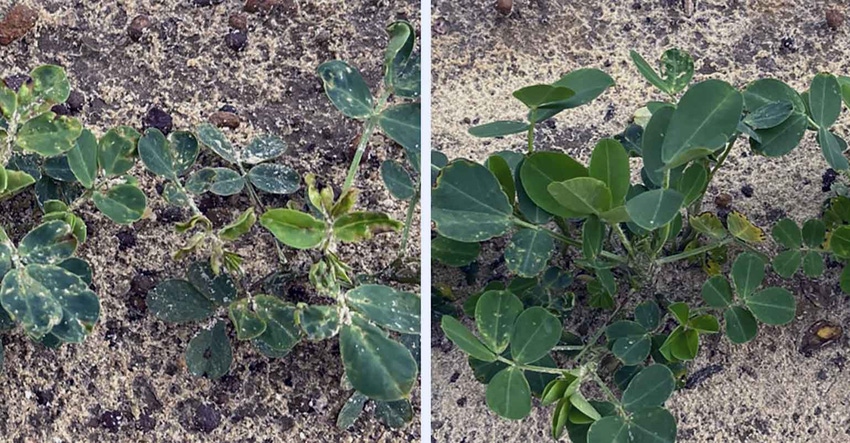May 31, 2022

The value of at-plant insecticides for thrips management was readily apparent in University of Georgia trials this week (of May 23) in Tifton.
While untreated peanuts were getting hammered (picture on the left above), all of the in-furrow insecticide treatments we are evaluating were holding up pretty good (picture on the right above: phorate treated).
Thrips injury generally peaks around 28 days after planting, and if the growing environment is favorable, the condition of plants rapidly improves after that. The recent rains in our area will help peanuts that experienced heavy thrips pressure recover and get on to the job of making peanuts.
I have not received many calls about foliar sprays for thrips. This means that we either did a good job with our in-furrow insecticide applications or we haven’t been walking fields. Research suggests that fields with heavy thrips injury at 28 days after plant are unlikely to benefit from a foliar insecticide application. By this time, the damage has been done. Drought conditions and/or herbicide injury can change the equation since plants will not recover from thrips as quickly given the additional stress.
Tomato spotted wilt was observed in a lot of our plots of 28 day old peanuts yesterday. The incidence of obvious symptoms was not high, but seeing the virus at 28 days is concerning. Plants infected at this age are likely to produce no yield and will probably die. There is nothing that can be done to reduce the spread of the virus once the crop has been planted.
Thankfully, not everyone in Georgia is experiencing heavy thrips pressure, and according to reports, east Georgia has been seeing relatively light thrips infestations.
Early May weather conditions in Georgia were perfect for the development of lesser cornstalk borer (LCB) populations. There are several dozen LCB pheromone traps in south Georgia peanut fields, and many of them have been catching moths. Hot, dry weather is the most important factor contributing to LCB outbreaks. We should be aware that moths are currently active, and we need to scout fields that are at high risk (dry, sandy soils and skippy stands). There is no need to make preventative treatments for LCB; scouting and treating when larvae are at threshold will save growers money.
If you have questions about these or other insect management issues in peanut, please contact your local UGA County Extension Agent.
About the Author(s)
You May Also Like




